Veterinary Anti Infectives Market Size
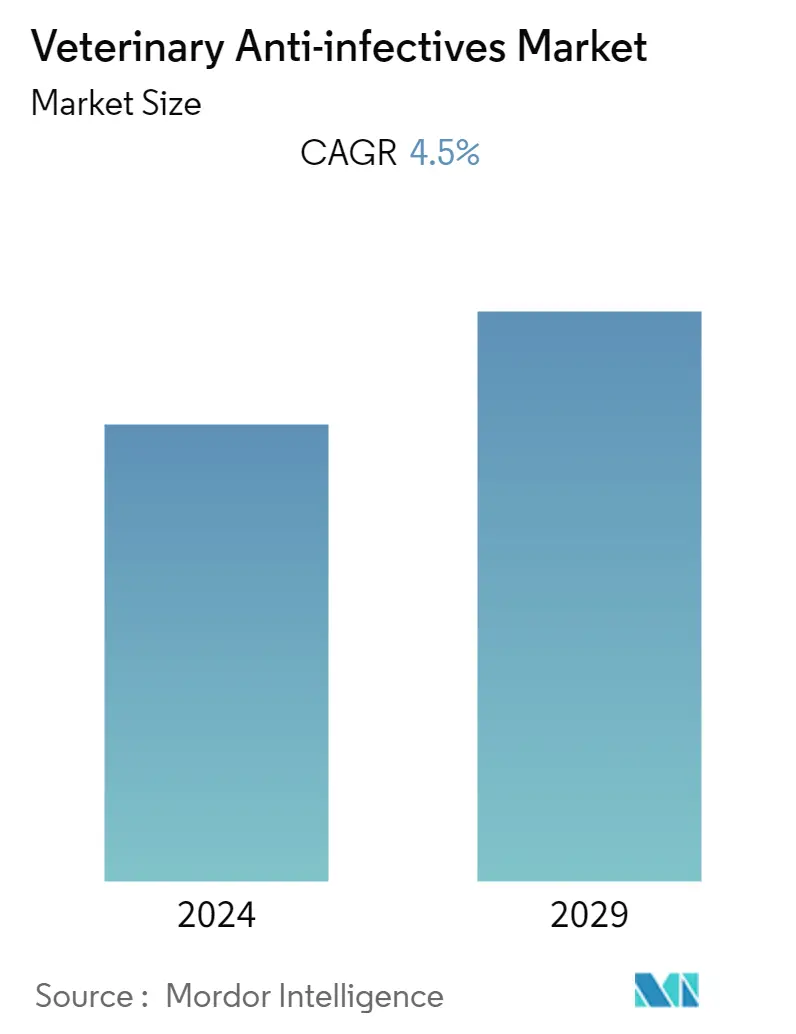
| Study Period | 2019 - 2029 |
| Base Year For Estimation | 2023 |
| Forecast Data Period | 2024 - 2029 |
| CAGR | 4.50 % |
| Fastest Growing Market | Asia Pacific |
| Largest Market | North America |
Major Players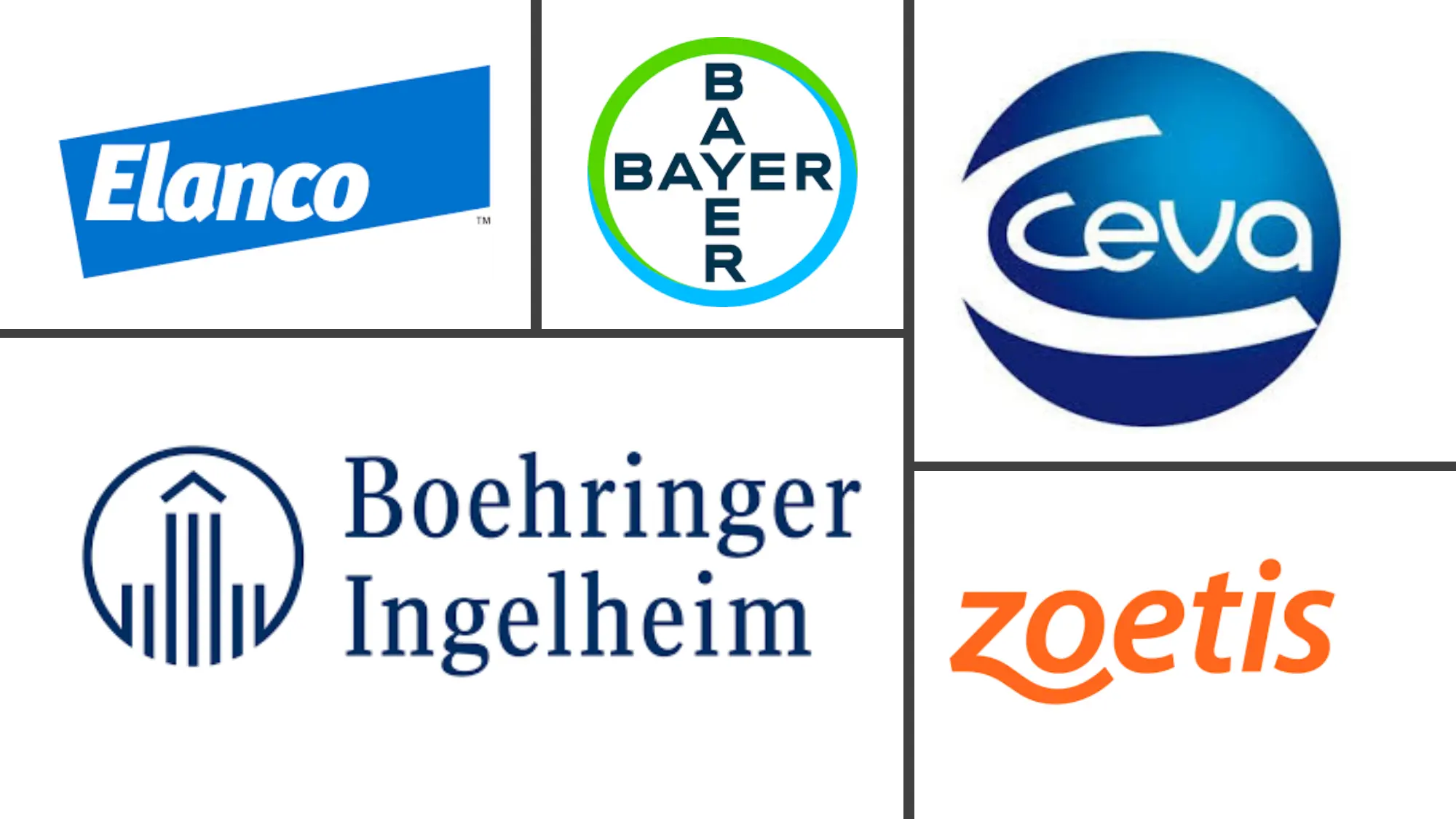
*Disclaimer: Major Players sorted in no particular order |
Veterinary Anti Infectives Market Analysis
The prevention and treatment of deadly animal diseases are key market indicators for veterinary anti-infectives. Certain factors such as increasing zoonotic and foodborne diseases, rising pet ownership and rising R&D activities in animal healthcare. The zoonotic and foodborne diseases are naturally transmitted from animals to humans, due to the consumption of contaminated food and water, exposure to the pathogen during preparation, processing, or by direct contact with infected animals or humans. Zoonotic diseases are quite common around the world. According to the scientists of Centers for Disease Control and Prevention (CDC), over 6 out of every 10 known infectious diseases in humans are spread via animals, moreover, 3 out of every 4 new or emerging infectious diseases are spread from animals.So, it is evident that these diseases are major public health problem worldwide. Thus, increasing burden of zoonotic diseases is expected to impact the growth of the market.
Veterinary Anti Infectives Market Trends
This section covers the major market trends shaping the Veterinary Anti Infectives Market according to our research experts:
Cattle Sub-Segment is Expected to Show Better Growth in the Forecast Years
Based on Animal Type, it is segmented into cattle, poultry, cats, dogs and other animals. The growth of the cattle sub-segment is mainly attributed to the high population of cattle across the world and the dominance of cattle farming as a major income source for people in many countries. For example, in countries such as China and Mexico where the livestock population is high, the market for cattle anti-infective products is larger compared to the developed countries. According to the Food and Agriculture Organization (FAO), the worldwide population of cattle is more than 1.4 billion, out of which a large proportion is noted in countries such as India, Brazil, and China. Furthermore, in 2019, Bimeda received FDA approval for OxyMed LA indicated to treat bacterial enteritis in swine and cattle. Hence, new product approval, awareness about cattle diseases and zoonosis are anticipated to have a positive impact on the market in the coming years.
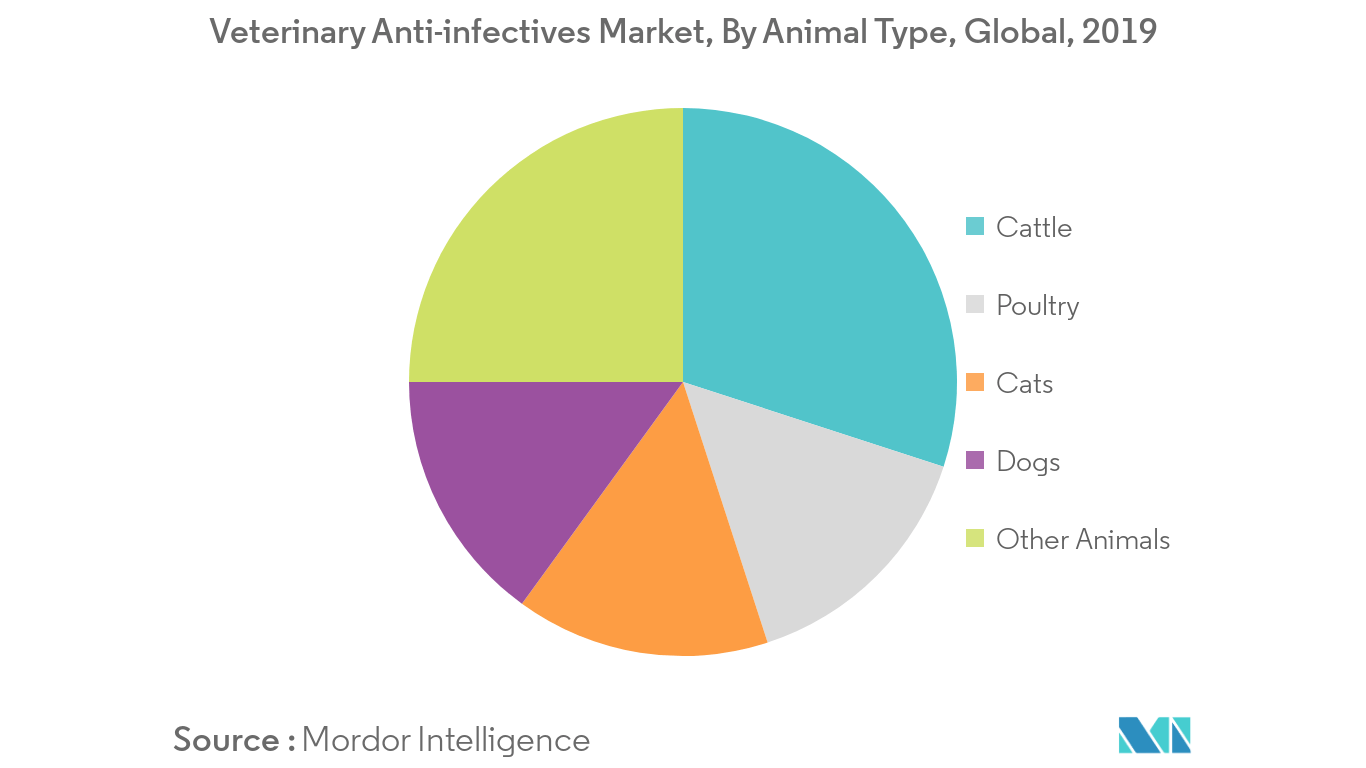
North America Dominates the Veterinary Anti-infectives Market
North America region is among the major contributor to livestock and the implementation of animal healthcare benefits across the region. The market is growing rapidly due to the presence of advanced animal healthcare programs coupled with awareness regarding animal health is projected to drive the regional market growth. According to 2017 data by the North American Meat Institute, the poultry and meat industries are the largest division of the United States agriculture sector. Moreover, rising disease burden in animals is further pushing the need for effective and quick treatment options which is expected to propel the growth of the market, over the forecast period.
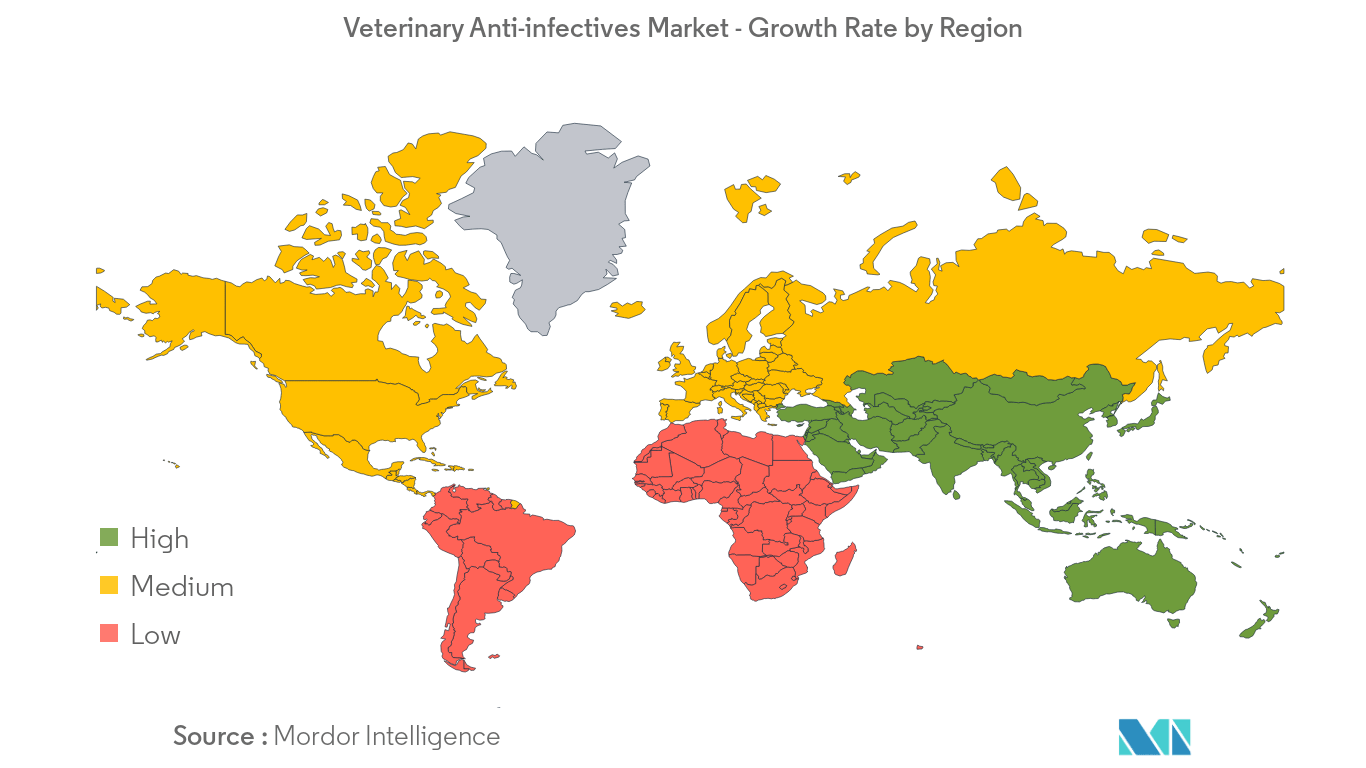
Veterinary Anti Infectives Industry Overview
The global players in the veterinary anti-infectives market are – Bayer AG, Boehringer Ingelheim GmbH, Ceva Santé Animale, Elanco, Merck & Co Inc., Phibro Animal Health Corporation, Vetoquinol S.A., Virbac and Zoetis Inc.
Veterinary Anti Infectives Market Leaders
-
Bayer AG
-
Boehringer Ingelheim GmbH
-
Ceva Santé Animale
-
Elanco
-
Zoetis Inc.
*Disclaimer: Major Players sorted in no particular order
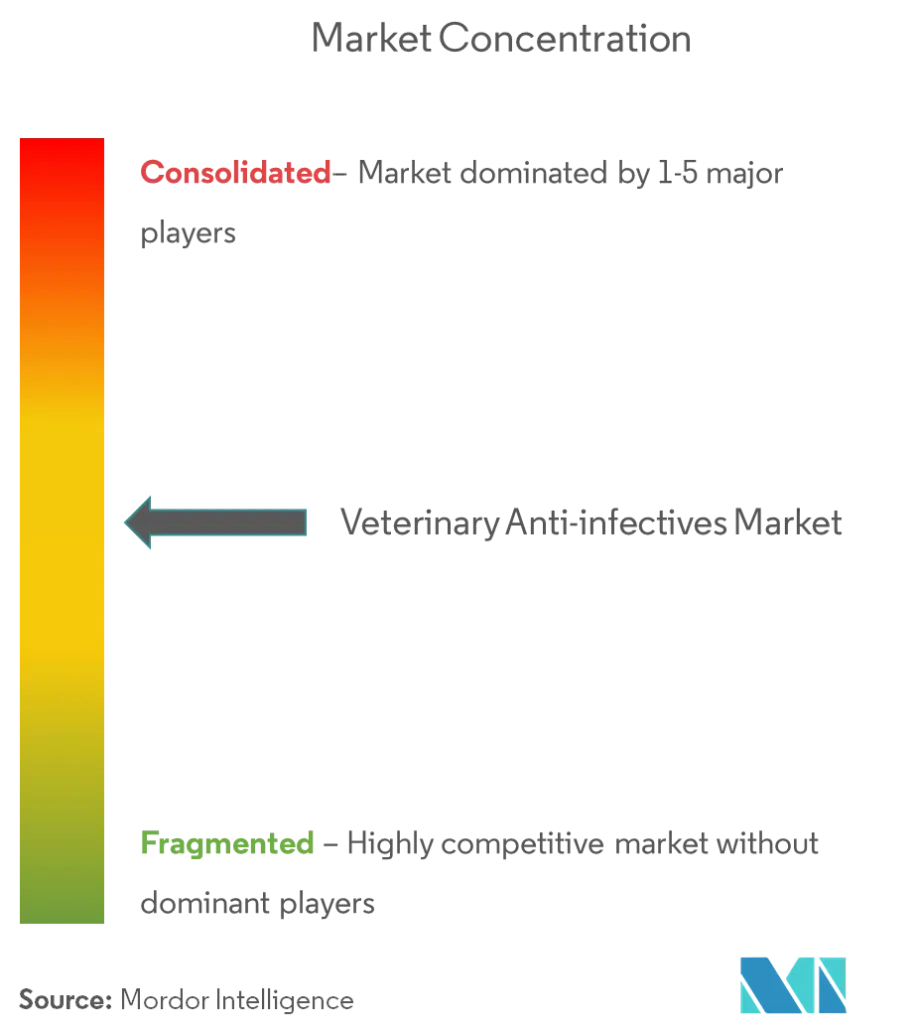
Veterinary Anti Infectives Market Report - Table of Contents
1. INTRODUCTION
- 1.1 Study Deliverables
- 1.2 Study Assumptions
- 1.3 Scope of the Study
2. RESEARCH METHODOLOGY
3. EXECUTIVE SUMMARY
4. MARKET DYNAMICS
- 4.1 Market Overview
-
4.2 Market Drivers
- 4.2.1 Increasing Zoonotic and Foodborne Diseases
- 4.2.2 Rising Pet Ownership
- 4.2.3 Rising R&D Activities in Animal Healthcare
-
4.3 Market Restraints
- 4.3.1 Use of Counterfeit Medicines
- 4.3.2 Increasing Cost of Veterinary Services
-
4.4 Porter's Five Forces Analysis
- 4.4.1 Threat of New Entrants
- 4.4.2 Bargaining Power of Buyers/Consumers
- 4.4.3 Bargaining Power of Suppliers
- 4.4.4 Threat of Substitute Products
- 4.4.5 Intensity of Competitive Rivalry
5. MARKET SEGMENTATION
-
5.1 By Animal Type
- 5.1.1 Cattle
- 5.1.2 Poultry
- 5.1.3 Cats
- 5.1.4 Dogs
- 5.1.5 Other Animals
-
5.2 By Product Type
- 5.2.1 Antibacterial
- 5.2.2 Antivirals
- 5.2.3 Antifungals
- 5.2.4 Others
-
5.3 By Mode of Administration
- 5.3.1 Oral
- 5.3.2 Topical
- 5.3.3 Others
-
5.4 Geography
- 5.4.1 North America
- 5.4.1.1 United States
- 5.4.1.2 Canada
- 5.4.1.3 Mexico
- 5.4.2 Europe
- 5.4.2.1 France
- 5.4.2.2 Germany
- 5.4.2.3 United Kingdom
- 5.4.2.4 Italy
- 5.4.2.5 Spain
- 5.4.2.6 Rest of Europe
- 5.4.3 Asia-Pacific
- 5.4.3.1 China
- 5.4.3.2 Japan
- 5.4.3.3 India
- 5.4.3.4 Australia
- 5.4.3.5 South Korea
- 5.4.3.6 Rest of Asia-Pacific
- 5.4.4 Middle-East and Africa
- 5.4.4.1 GCC
- 5.4.4.2 South Africa
- 5.4.4.3 Rest of Middle-East and Africa
- 5.4.5 South America
- 5.4.5.1 Brazil
- 5.4.5.2 Argentina
- 5.4.5.3 Rest of South America
6. COMPETITIVE LANDSCAPE
-
6.1 Company Profiles
- 6.1.1 Bayer AG
- 6.1.2 Boehringer Ingelheim GmbH
- 6.1.3 Ceva Sante Animale
- 6.1.4 Elanco
- 6.1.5 Merck & Co Inc.
- 6.1.6 Phibro Animal Health Corporation
- 6.1.7 Vetoquinol S.A.
- 6.1.8 Virbac
- 6.1.9 Zoetis Inc.
- *List Not Exhaustive
7. MARKET OPPORTUNITIES AND FUTURE TRENDS
** Subject To AvailablityVeterinary Anti Infectives Industry Segmentation
As per the scope of the report, Anti-infectives include a wide range of animal health products which prevent infectious agents or organisms from spreading. These include Antibacterial, Antivirals, Antifungals, etc.
| By Animal Type | Cattle | |
| Poultry | ||
| Cats | ||
| Dogs | ||
| Other Animals | ||
| By Product Type | Antibacterial | |
| Antivirals | ||
| Antifungals | ||
| Others | ||
| By Mode of Administration | Oral | |
| Topical | ||
| Others | ||
| Geography | North America | United States |
| Canada | ||
| Mexico | ||
| Geography | Europe | France |
| Germany | ||
| United Kingdom | ||
| Italy | ||
| Spain | ||
| Rest of Europe | ||
| Geography | Asia-Pacific | China |
| Japan | ||
| India | ||
| Australia | ||
| South Korea | ||
| Rest of Asia-Pacific | ||
| Geography | Middle-East and Africa | GCC |
| South Africa | ||
| Rest of Middle-East and Africa | ||
| Geography | South America | Brazil |
| Argentina | ||
| Rest of South America |
Veterinary Anti Infectives Market Research FAQs
What is the current Veterinary Anti-infectives Market size?
The Veterinary Anti-infectives Market is projected to register a CAGR of 4.5% during the forecast period (2024-2029)
Who are the key players in Veterinary Anti-infectives Market?
Bayer AG, Boehringer Ingelheim GmbH, Ceva Santé Animale, Elanco and Zoetis Inc. are the major companies operating in the Veterinary Anti-infectives Market.
Which is the fastest growing region in Veterinary Anti-infectives Market?
Asia Pacific is estimated to grow at the highest CAGR over the forecast period (2024-2029).
Which region has the biggest share in Veterinary Anti-infectives Market?
In 2024, the North America accounts for the largest market share in Veterinary Anti-infectives Market.
What years does this Veterinary Anti-infectives Market cover?
The report covers the Veterinary Anti-infectives Market historical market size for years: 2019, 2020, 2021, 2022 and 2023. The report also forecasts the Veterinary Anti-infectives Market size for years: 2024, 2025, 2026, 2027, 2028 and 2029.
Veterinary Anti-infectives Industry Report
Statistics for the 2024 Veterinary Anti-infectives market share, size and revenue growth rate, created by Mordor Intelligence™ Industry Reports. Veterinary Anti-infectives analysis includes a market forecast outlook to 2029 and historical overview. Get a sample of this industry analysis as a free report PDF download.



